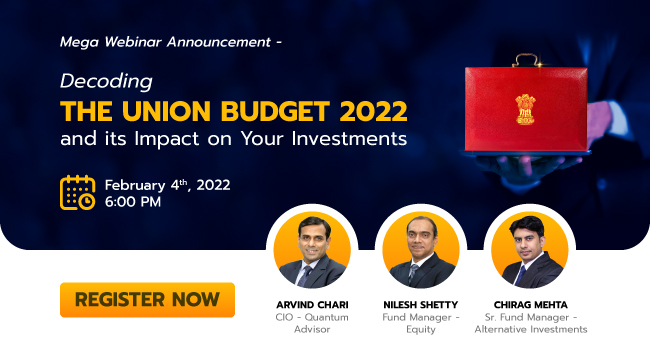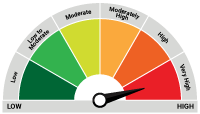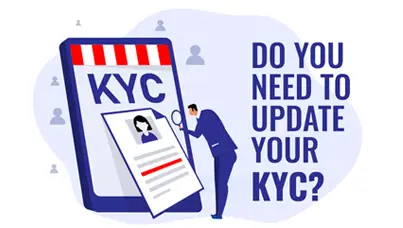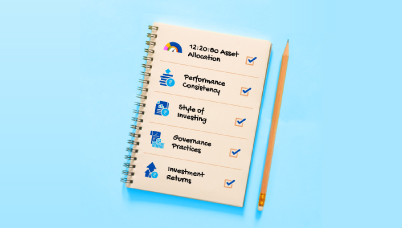Union Budget 2022-23 – A Quantum Perspective
Posted On Wednesday, Feb 02, 2022
Increased capex spending and prioritizing long term growth have been the underlying theme of the Union Budget 2022-23. Get detailed perspectives into the budget from the CIO of Quantum Advisors and our fund managers, who analyze how the different asset classes are set to fare.


1. Boosting growth through Capex spending:
There are several tailwinds to the Indian economy, and we are on the cusp of a sustained economic revival. The Government has stuck to its priority to boost growth over fiscal consolidation. This should enable the continued economic recovery and extend the growth over the next 2-3 years.
The budget for Capital Expenditure spending from INR 5.5 trillion budgeted for FY 22 to INR 7.5 trillion for FY 23 is a massive increase.
If the Central and the State government can implement and spend those amounts in a timely and efficient manner, it could lead to a multiplier effect in the economy.
We had noted that this increase in government CAPEX spending should be able to revive private CAPEX activity and bodes well for Indian equities over the medium term.
2. Bond Yields Set to Rise
The priority towards growth means that the bond markets will see a slower fiscal consolidation and will have to face a very high level of borrowing both from the Centre and States.
In the backdrop of higher oil prices, a hawkish US FED and the pressure on the RBI to tighten monetary policy, the higher borrowing will see bond yields rising.
Across the yield curve, over the course of the year, we will expect bond yields to rise by 20-30 bps for now.
The RBI will also have to start hiking its policy rates and we would expect at least a 100 bps increase in rates in FY 23.
3. Low demand support
The major disappointment continued to remain on the Governments focus on boosting supply side over demand. We would have loved to see some balance between boosting industry and supporting individuals.
4. No reduction in import duties
The economy faces short term risks from higher global and domestic inflation. In this respect, the Government’s continued increase in import duties to boost domestic manufacturing on the back of improving growth will lead to higher cost pressures in the economy. We would have liked to see the government take some measures to manage future cost pressures with duty cuts.
5. Lack of rural employment measures:
The announcement also had no mention of rural employment, the impact on the informal enterprises and the continued divide between the formal and the informal economy. We do recognize that higher growth will trickle down over time, however, there should have been some immediate relief to the economic segments which were impacted by the pandemic.

• The Government continues to focus on the supply side through high allocation to CAPEX.
• While this is good for the long term, we believe a boost on the demand side through tax cuts would have helped the economy in the near term via higher consumption.
• The Government has resisted being populist despite big state elections & which is a big positive.
• Domestic focused cyclical sectors like banks, materials & capital goods are expected to do well.
What investors should do:
Keep invested and use a long-term horizon
Equities remain an attractive asset class and is expected to do well over the long term. Investors are advised to remain invested and take opportunity of the recent correction.
Build an equity portfolio in the 70-15-15 ratio where Quantum Equity Fund of Funds can be your core holding (70%) and then a periphery of Quantum Long Term Equity Value Fund (15%) and Quantum India ESG Equity Fund (15%) around it to diversify your equity allocation basket from a long-term perspective.

From the bond market’s prospective, the budget was negative due to the following reasons.
• Higher than expected Fiscal deficit
• Absence of any announcement on global bond index inclusion
• Higher borrowing requirements of the Center and state governments will put pressure on the bond markets.
What investors should do:
We expect bond yields to further surge with a bigger impact on the longer-term bond yields.
Fixed Income investors should stick to categories like liquid funds or other short-duration fund categories.

1. No reduction in gold duty – a missed opportunity
Finance Minister Nirmala Sitharaman disappointed gold markets by skipping to reduce custom duty on gold in the Union Budget of 2022-23.
Higher government intervention through higher custom duty has over the years ensured that India, despite being the world’s second-largest consumer of gold, importing 800-900 tons annually, is a price taker.
2. Gold prices determinants
International gold prices are used to set the domestic gold price in India. The International gold price is used as a base price and converted to Indian rupees using the Dollar/ Rupee rate and we add to it various Indian duties and levies to arrive at the Indian gold price.
3. Difference in Domestic and International Gold Prices
Custom duty on gold currently stands at 10.75% which is very high and contributes to price distortions, working against the various gold market initiatives undertaken by the government.
High customs duty has caused a differential between the Indian gold prices and international gold price has widened to about 14% in total (10.75% (customs duty + Cess + Social welfare surcharge) + 3% GST).
A duty reduction can help bring domestic gold prices closer to international prices to the extent of reduction in levy and enable more efficient functioning of the gold markets in India.
4. Disadvantages of price differential
• Creates lucrative margins and encourages illicit gold imports of precious metal
• Makes it difficult to channelize the hoard of India’s gold savings into circulation and thereby integrate the gold market with other financial markets
Thus, rationalizing the custom duty and minimizing these price distortions have been a long-standing demand of the bullion industry which we believe will go a long way in developing the gold sector and bringing India to the Centre of international gold markets. Rising government revenues did provide them with a window of opportunity to rectify this anomaly for the greater good of consumers and the development of gold markets. However, it seems like a missed opportunity this time around.
What investors should do
Gold to continue as a risk-diversifying portfolio diversifier
Gold remains as an efficient portfolio diversifier. The current volatility in equity markets is a good opportunity to increase allocation to Gold so that it occupies up to 20% of your overall portfolio.
On Sustainability Initiatives
“Great Sustainability Measures and Policies but falls short of ambition, does not include incentives for corporates” – Chirag Mehta, Fund Manager
Sustainability Measures taken by the Government include:
• Single window green clearances
• Additional sources of funding that now include Green bonds, Blended finance were necessary to channelize sustainable capital in India.
• Battery swapping could provide EV the big push with the right policies and execution.
• PLI incentives for solar module manufacturing will help reduce our reliance on imports and circular economy initiatives will provide the regulatory push for much needed implementation.
However, the Government seems to be doing some heavy lifting which may not be enough. Private sector needs to be brought in to make the desirable changes towards the ambitious cleaner, greener India which now seems to be missing.
Such incentives, to name a few can include:
• Incentives to corporates to increase their share of renewable energy,
• CSR investments channelized towards sustainability initiatives,
• Incentives for technology and investments towards sustainability
Join our LIVE webinar this Friday 6 PM on Feb 04, 2022 where our speakers Arvind Chari, Nilesh Shetty and Chirag Mehta share some key highlights of the Union Budget 2022 and its impact on your investments.

Product Labeling
| Name of the Scheme & Primary Benchmark | This product is suitable for investors who are seeking* | Risk-o-meter of Scheme |
| Quantum Long Term Equity Value Fund An Open Ended Equity Scheme following a Value Investment Strategy Primary Benchmark: S&P BSE 500 TRI | • Long term capital appreciation • Invests primarily in equity and equity related securities of companies in S&P BSE 200 index. |  Investors understand that their principal will be at Very High Risk |
| Quantum Equity Fund of Funds An Open-ended Fund of Funds scheme Investing in Open Ended Diversified Equity Schemes of Mutual Funds Primary Benchmark: S&P BSE 200 TRI | • Long term capital appreciation • Investments in portfolio of open-ended diversified equity schemes of mutual funds registered with SEBI whose underlying investments are in equity and equity related securities of diversified companies. |  Investors understand that their principal will be at Very High Risk |
| Quantum India ESG Equity Fund An Open ended equity scheme investing in companies following Environment, Social and Governance (ESG) theme Primary Benchmark: NIFTY100 ESG TRI | • Long term capital appreciation • Invests in shares of companies that meet Quantum's Environment, Social, Governance (ESG) criteria. |  Investors understand that their principal will be at Very High Risk |
The Risk Level of the Scheme in scheme Risk O Meter is basis it's portfolio as on December 31, 2021.
The Risk Level of the Benchmark Index in the Risk O Meter is basis it's constituents as on December 31, 2021.
Disclaimer, Statutory Details & Risk Factors:
The views expressed here in this article / video are for general information and reading purpose only and do not constitute any guidelines and recommendations on any course of action to be followed by the reader. Quantum AMC / Quantum Mutual Fund is not guaranteeing / offering / communicating any indicative yield on investments made in the scheme(s). The views are not meant to serve as a professional guide / investment advice / intended to be an offer or solicitation for the purchase or sale of any financial product or instrument or mutual fund units for the reader. The article has been prepared on the basis of publicly available information, internally developed data and other sources believed to be reliable. Whilst no action has been solicited based upon the information provided herein, due care has been taken to ensure that the facts are accurate and views given are fair and reasonable as on date. Readers of this article should rely on information/data arising out of their own investigations and advised to seek independent professional advice and arrive at an informed decision before making any investments.
Mutual fund investments are subject to market risks read all scheme related documents carefully.
Please visit – www.QuantumAMC.com to read scheme specific risk factors. Investors in the Scheme(s) are not being offered a guaranteed or assured rate of return and there can be no assurance that the schemes objective will be achieved and the NAV of the scheme(s) may go up and down depending upon the factors and forces affecting securities market. Investment in mutual fund units involves investment risk such as trading volumes, settlement risk, liquidity risk, default risk including possible loss of capital. Past performance of the sponsor / AMC / Mutual Fund does not indicate the future performance of the Scheme(s). Statutory Details: Quantum Mutual Fund (the Fund) has been constituted as a Trust under the Indian Trusts Act, 1882. Sponsor: Quantum Advisors Private Limited. (liability of Sponsor limited to Rs. 1,00,000/-) Trustee: Quantum Trustee Company Private Limited. Investment Manager: Quantum Asset Management Company Private Limited. The Sponsor, Trustee and Investment Manager are incorporated under the Companies Act, 1956.
Related Posts
-

Do You Need to Update Your KYC/Modify KYC?
Posted On Friday, Apr 26, 2024
New KYC Regulation Effective April 1st 2024
Read More -

Are You Stuck in the Past or Ready for a Secure Future?
Posted On Wednesday, Jun 29, 2022
The ever-growing number of mutual fund schemes on offer has made it challenging for investors to select the best and most suitable one.
Read More -

Received an Increment? Step-up Your SIPs
Posted On Wednesday, Jun 01, 2022
For instance, let’s assume that you have registered for a monthly SIP of Rs 5,000 for a 10-year period and later on try to step-up the SIP at an annual frequency, say by Rs 500. In the first year...
Read More



